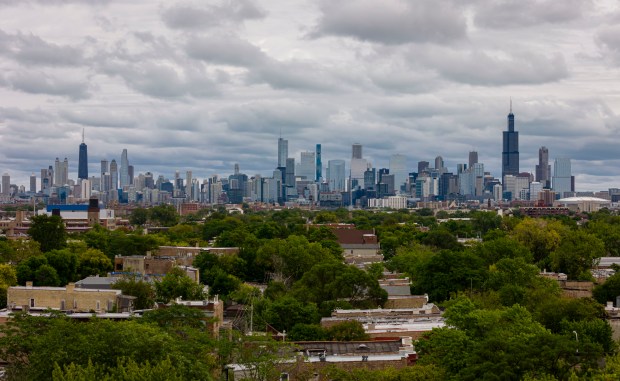Claudia Rodriguez said shootings are so frequent in her Chicago Lawn neighborhood that the sound of gunshots doesn’t surprise her. Despite the constant fear she and her children live in every day, she found some security in knowing that technology helped police respond to shootings fast, she said.
But on Monday morning, for the first time in years, a shooting near the hair salon where she works wasn’t picked up by the gunshot detection system known as ShotSpotter, a controversial mechanism Mayor Brandon Johnson has criticized as inaccurate and too expensive.
It was taken offline at 12:01 a.m. Monday, according to Chicago police Superintendent Larry Snelling. About 40 minutes later, a 32-year-old man was shot after a verbal altercation with another man on the sidewalk in the 3300 block of West 63rd Street.
It was the first police-reported shooting to not be picked up by the technology.
ShotSpotter, widely adopted by the city six years ago, used acoustic sensors mounted on light poles to alert police about the location of suspected gunfire. The software has been consistently praised by police, including Snelling, who credit it for quicker responses to shootings.
Aldermen overwhelmingly voted in favor of keeping the technology system last week, but Mayor Brandon Johnson, who campaigned on ending the city’s use of the technology, vetoed it, arguing it doesn’t work well enough to justify its cost.
Indeed in 2021, it gained notoriety after a gunshot alert from a street in Little Village sent responding police running after 13-year-old Adam Toledo. An officer fatally shot him during the chase. Monday, Johnson asked businesses to offer up new violent crime response alternatives.
But its removal has Rodriguez concerned.
“It’s very worrying,” said Rodriguez, 43, in Spanish, when asked what she thought about the city’s decision to take the software offline Sunday night. “But I also think there will be little change here.”
Rodriguez moved to Chicago from Cuernavaca, Mexico, three years ago to be with her husband who was already living in the city. She started working at the barber shop about a month ago.
She’d heard about the overnight shooting near her new workplace, but she didn’t know any more details. According to police, the 32-year-old man was shot multiple times and transported to Holy Cross Hospital in fair condition.
Her 16-year-old daughter goes to Mansueto High School, and she said she was worried about shootings popping up in and around school.
“Violence here comes from a lack of parental attention,” she said.
Rodriguez said it’s a challenge many families in the neighborhood face: where parents, out of necessity like her, work long hours and may not be able to give as much attention to their children as they would like. She worries about the ability of children or teen gunshot victims to get medical aid fast.
She also questioned the effectiveness of the tool. She said she often falls asleep to gunshots, and seldom does she hear police arrive immediately.
“I don’t know at what level you have to be shot at to have the police arrive,” she said.
On Sunday, Snelling sent an email to all Police Department members announcing the discontinuation of ShotSpotter.
“Our communities that are affected by gun violence are still relying on us to do everything we can to protect them and that’s what we will continue to do,” Snelling wrote in the email, a copy of which was provided to the Tribune. “Just like any other time we’ve faced changes in our operations, we will adjust and continue in our public safety efforts. This city is our home and we will keep it safe no matter the circumstances.”
With ShotSpotter gone, Snelling wrote, CPD officers should encourage members of the public to call 911 “if they hear loud noises resembling gunshots.”
But sometimes calling 911 isn’t quick enough, said Rikita Mitchell, 39, while waiting in line outside Above and Beyond Food Pantry in West Garfield Park Monday afternoon.
About 5 a.m. that morning, a 22-year-old man was shot in the right buttocks a few blocks from the food pantry. According to Chicago police, the man was taken to Stroger Hospital in fair condition.
Mitchell said she was not in favor of ending ShotSpotter.
On New Year’s Day this year, Mitchell saw police officers respond to a shooting in the Austin neighborhood, she said.
“They came immediately,” she said.
She said police quickly questioned her about the incident. Without ShotSpotter technology, she doesn’t think there will be all as many split-second responses from police.
Mitchell said she wasn’t even sure why ShotSpotter was being discontinued. Authorities should have gotten rid of technology that monitors traffic violations before tossing out ShotSpotter, she added.
David Bailey, 68, also visited the food pantry in Garfield Park Monday. Bailey was born and raised in Chicago and said he thought ShotSpotter was a beneficial technology that provided police information about where shootings occurred.
“Now, how will the police know where all the shootings are?” he asked.
The technology might have even deterred people from committing shootings because ShotSpotter helps police officers get to crime scenes faster, Bailey said.
Alyssa Rusak, 37, a social worker who works at the pantry, said in her experience, most of the people involved in shootings in the area call 911 on their own.
“From what I can tell, it’s never made a big difference,” she said. “I don’t even think it registers with people.”
Rusak said most people she talks to are confused about the acoustic sensors attached to buildings and light poles. Instead of gunshot detection boxes, she said there should be more attention on building trust, protecting youth and mitigating conflict within communities.
Chicago Tribune’s Sam Charles and Jake Sheridan contributed.



